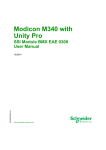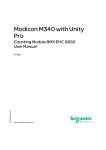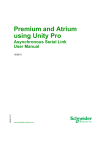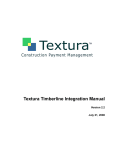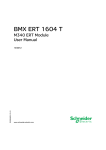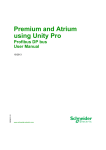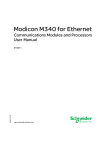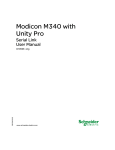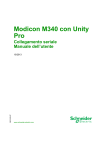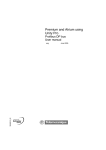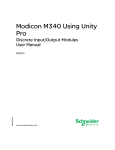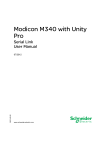Download Modicon M340 with Unity Pro - SSI Module BMX EAE 0300
Transcript
Modicon M340 with Unity Pro EIO0000000940 07/2012 Modicon M340 with Unity Pro SSI Module BMX EAE 0300 User Manual EIO0000000940.01 07/2012 www.schneider-electric.com The information provided in this documentation contains general descriptions and/or technical characteristics of the performance of the products contained herein. This documentation is not intended as a substitute for and is not to be used for determining suitability or reliability of these products for specific user applications. It is the duty of any such user or integrator to perform the appropriate and complete risk analysis, evaluation and testing of the products with respect to the relevant specific application or use thereof. Neither Schneider Electric nor any of its affiliates or subsidiaries shall be responsible or liable for misuse of the information that is contained herein. If you have any suggestions for improvements or amendments or have found errors in this publication, please notify us. No part of this document may be reproduced in any form or by any means, electronic or mechanical, including photocopying, without express written permission of Schneider Electric. All pertinent state, regional, and local safety regulations must be observed when installing and using this product. For reasons of safety and to help ensure compliance with documented system data, only the manufacturer should perform repairs to components. When devices are used for applications with technical safety requirements, the relevant instructions must be followed. Failure to use Schneider Electric software or approved software with our hardware products may result in injury, harm, or improper operating results. Failure to observe this information can result in injury or equipment damage. © 2012 Schneider Electric. All rights reserved. 2 EIO0000000940 07/2012 Table of Contents Safety Information . . . . . . . . . . . . . . . . . . . . . . . . . . . . . . About the Book . . . . . . . . . . . . . . . . . . . . . . . . . . . . . . . . . Part I BMX EAE 0300 Overview . . . . . . . . . . . . . . . . . . . . . . Chapter 1 Module Introduction . . . . . . . . . . . . . . . . . . . . . . . . . . . . . General Information about SSI Functions . . . . . . . . . . . . . . . . . . . . . . . . . General Information about the SSI Module BMX EAE 0300 . . . . . . . . . . . Physical Description of the SSI Module BMX EAE 0300 . . . . . . . . . . . . . Characteristics of the SSI Module BMX EAE 0300 . . . . . . . . . . . . . . . . . . Environment . . . . . . . . . . . . . . . . . . . . . . . . . . . . . . . . . . . . . . . . . . . . . . . Standards . . . . . . . . . . . . . . . . . . . . . . . . . . . . . . . . . . . . . . . . . . . . . . . . . Chapter 2 SSI Module Installation . . . . . . . . . . . . . . . . . . . . . . . . . . Mounting the SSI Module BMX EAE 0300 . . . . . . . . . . . . . . . . . . . . . . . . Mounting the BMX FTB 2800/2820 Terminal Block . . . . . . . . . . . . . . . . . How to Avoid Electromagnetic Interference . . . . . . . . . . . . . . . . . . . . . . . LED Indicators. . . . . . . . . . . . . . . . . . . . . . . . . . . . . . . . . . . . . . . . . . . . . . Chapter 3 Inputs/Outputs Specifications. . . . . . . . . . . . . . . . . . . . . 5 7 9 11 12 13 14 15 16 17 19 20 22 25 27 31 Capture Digital Input Characteristics. . . . . . . . . . . . . . . . . . . . . . . . . . . . . Reflex Digital Output Characteristics. . . . . . . . . . . . . . . . . . . . . . . . . . . . . Programmable Input Filtering . . . . . . . . . . . . . . . . . . . . . . . . . . . . . . . . . . 32 33 35 Part II SSI Module BMX EAE 0300 Functionalities . . . . . . . 37 Chapter 4 Configuration parameters . . . . . . . . . . . . . . . . . . . . . . . . Configuration Screen for the SSI Module BMX EAE 0300 . . . . . . . . . . . . Chapter 5 SSI Module BMX EAE 0300 Functions . . . . . . . . . . . . . . SSI Interface . . . . . . . . . . . . . . . . . . . . . . . . . . . . . . . . . . . . . . . . . . . . . . . Modulo and Reduction Functions . . . . . . . . . . . . . . . . . . . . . . . . . . . . . . . Offset Function . . . . . . . . . . . . . . . . . . . . . . . . . . . . . . . . . . . . . . . . . . . . . Inverted SSI Direction Function. . . . . . . . . . . . . . . . . . . . . . . . . . . . . . . . . Multiple Application of Reformatting . . . . . . . . . . . . . . . . . . . . . . . . . . . . . Capture Function. . . . . . . . . . . . . . . . . . . . . . . . . . . . . . . . . . . . . . . . . . . . EIO0000000940 07/2012 39 39 41 42 43 44 45 46 47 3 Compare Function . . . . . . . . . . . . . . . . . . . . . . . . . . . . . . . . . . . . . . . . . . SSI Status Register . . . . . . . . . . . . . . . . . . . . . . . . . . . . . . . . . . . . . . . . . Event Sent To Application . . . . . . . . . . . . . . . . . . . . . . . . . . . . . . . . . . . . Output Block Functions . . . . . . . . . . . . . . . . . . . . . . . . . . . . . . . . . . . . . . 49 52 53 54 Chapter 6 Adjustment . . . . . . . . . . . . . . . . . . . . . . . . . . . . . . . . . . . . . 57 Screen for the SSI Module BMX EAE 0300. . . . . . . . . . . . . . . . . . . . . . . 57 Chapter 7 Debugging the SSI Module BMX EAE 0300 . . . . . . . . . . . 59 Debug Screen for the SSI Module BMX EAE 0300 . . . . . . . . . . . . . . . . . 59 Chapter 8 Diagnostic of the SSI Module BMX EAE 0300 . . . . . . . . . 61 Diagnostic Screen for the SSI Module BMX EAE 0300 . . . . . . . . . . . . . . 61 Chapter 9 The Language Objects of the SSI Function. . . . . . . . . . . 63 9.1 The Language Objects and IODDT of the SSI Function . . . . . . . . . . . . . Introducing Language Objects for Application-Specific SSI. . . . . . . . . . . Implicit Exchange Language Objects Associated with the ApplicationSpecific Function . . . . . . . . . . . . . . . . . . . . . . . . . . . . . . . . . . . . . . . . . . . Explicit Exchange Language Objects Associated with the ApplicationSpecific Functions . . . . . . . . . . . . . . . . . . . . . . . . . . . . . . . . . . . . . . . . . . Management of Exchanges and Reports with Explicit Objects . . . . . . . . 9.2 Language Objects and IODDTs Associated with the SSI Function . . . . . General Information . . . . . . . . . . . . . . . . . . . . . . . . . . . . . . . . . . . . . . . . . Implicit Exchange Objects for the T _SSI_BMX IODDT . . . . . . . . . . . . . 9.3 The IODDT Type T_GEN_MOD Applicable to All Modules . . . . . . . . . . . Language Objects of the IODDT of Type T_GEN_MOD . . . . . . . . . . . . . 64 65 67 69 73 74 75 79 79 Part III Quick Start: SSI Module BMX EAE 0300 Implementation Example . . . . . . . . . . . . . . . . . . . . . . . . . . . . . . 81 Chapter 10 Example Overview . . . . . . . . . . . . . . . . . . . . . . . . . . . . . . . 83 Example Introduction . . . . . . . . . . . . . . . . . . . . . . . . . . . . . . . . . . . . . . . . Application Background . . . . . . . . . . . . . . . . . . . . . . . . . . . . . . . . . . . . . . 84 85 Chapter 11 Hardware Installation. . . . . . . . . . . . . . . . . . . . . . . . . . . . . 87 Mounting the Module and the Terminal Block . . . . . . . . . . . . . . . . . . . . . Wiring Diagram of the Process . . . . . . . . . . . . . . . . . . . . . . . . . . . . . . . . 88 89 Chapter 12 Configuring the SSI Module BMX EAE 0300 on Unity Pro 4 66 91 Configuration of the SSI Module BMX EAE 0300 . . . . . . . . . . . . . . . . . . 91 Chapter 13 Programming the Example . . . . . . . . . . . . . . . . . . . . . . . . 95 Declaration of Variables. . . . . . . . . . . . . . . . . . . . . . . . . . . . . . . . . . . . . . Creating the Program. . . . . . . . . . . . . . . . . . . . . . . . . . . . . . . . . . . . . . . . Transferring the Project between the Terminal and the PLC. . . . . . . . . . 96 97 98 Chapter 14 Diagnostic and Debugging . . . . . . . . . . . . . . . . . . . . . . . . 103 Monitor the Application . . . . . . . . . . . . . . . . . . . . . . . . . . . . . . . . . . . . . . 103 Index . . . . . . . . . . . . . . . . . . . . . . . . . . . . . . . . . . . . . . . . . . . 101 EIO0000000940 07/2012 Safety Information § Important Information NOTICE Read these instructions carefully, and look at the equipment to become familiar with the device before trying to install, operate, or maintain it. The following special messages may appear throughout this documentation or on the equipment to warn of potential hazards or to call attention to information that clarifies or simplifies a procedure. EIO0000000940 07/2012 5 PLEASE NOTE Electrical equipment should be installed, operated, serviced, and maintained only by qualified personnel. No responsibility is assumed by Schneider Electric for any consequences arising out of the use of this material. A qualified person is one who has skills and knowledge related to the construction and operation of electrical equipment and its installation, and has received safety training to recognize and avoid the hazards involved. 6 EIO0000000940 07/2012 About the Book At a Glance Document Scope This manual describes the hardware and software implementation of SSI (Synchronous Serial Interface) module BMX EAE 0300 for Modicon M340 PLCs. Validity Note This documentation is valid for Unity Pro 7.0. Product Related Information WARNING UNINTENDED EQUIPMENT OPERATION The application of this product requires expertise in the design and programming of control systems. Only persons with such expertise should be allowed to program, install, alter, and apply this product. Follow all local and national safety codes and standards. Failure to follow these instructions can result in death, serious injury, or equipment damage. User Comments We welcome your comments about this document. You can reach us by e-mail at [email protected]. EIO0000000940 07/2012 7 8 EIO0000000940 07/2012 Modicon M340 with Unity Pro Overview EIO0000000940 07/2012 BMX EAE 0300 Overview I Overview This part gives an overview of the SSI module BMX EAE 0300 and its technical specifications. What Is in This Part? This part contains the following chapters: Chapter EIO0000000940 07/2012 Chapter Name Page 1 Module Introduction 11 2 SSI Module Installation 19 3 Inputs/Outputs Specifications 31 9 Overview 10 EIO0000000940 07/2012 Modicon M340 with Unity Pro Introduction EIO0000000940 07/2012 Module Introduction 1 Overview This chapter gives an overview of the SSI module. What Is in This Chapter? This chapter contains the following topics: Topic EIO0000000940 07/2012 Page General Information about SSI Functions 12 General Information about the SSI Module BMX EAE 0300 13 Physical Description of the SSI Module BMX EAE 0300 14 Characteristics of the SSI Module BMX EAE 0300 15 Environment 16 Standards 17 11 Introduction General Information about SSI Functions Overview Description The module BMX EAE 0300 is a synchronous serial interface designed for use with an absolute encoder, it is controlled by the user applications through an open SSI interface. The position values of the SSI channel are automatically read by the module every fixed period, unless the channel is disabled. Available Functions The following table presents the main functionalities of the BMX EAE 0300 module: 12 Function Description Modulo The modulo function limits the dynamics of the position value within the power of 2. An event (if enabled) detects the modulo passing. The reflex output can also be asserted at the passing of modulo (if configured). Reduction This function reduces the intrinsic resolution of the encoder by a value defined by the "reduction" parameter. This reduction is carried out by a shift in the bit field provided by the encoder. Offset The correction function of the encoder offset systematically corrects the offset produced by the encoder at mechanical position "0". The user enters the absolute encoder offset parameter. Capture The two capture input registers (per channel) enable the PLC program to carry out a dynamic measurement function between two points. The capture action can be triggered by two capture inputs. The event will be triggered at each occurrence of Capture. Compare Two independent comparators (per channel), with thresholds that can be modified by adjustment (explicit exchange), are able to generate an event or reflex output when the threshold is crossed. EIO0000000940 07/2012 Introduction General Information about the SSI Module BMX EAE 0300 Definition The SSI module BMX EAE 0300 is a 3-channel, synchronous serial interface, absolute encoder interface for Modicon M340 PLCs. It supports: 3 channels of SSI inputs 1 reflex output for each SSI channel 2 capture inputs for the 3 SSI channels 8 to 31 bits data width 4 ranks of baud rates (100 kHz, 200 kHz, 500 kHz, 1 MHz) capture and compare functions Illustration The illustration below shows the basic components of an absolute encoder system: 1 2 3 EIO0000000940 07/2012 Absolute encoder Proximity sensors SSI module BMX EAE 0300 13 Introduction Physical Description of the SSI Module BMX EAE 0300 Illustration The figure below presents the SSI module BMX EAE 0300: 1 2 BMX EAE 0300 28-pin removable terminal block NOTE: The terminal block is supplied separately. Required Accessories The SSI module BMX EAE 0300 requires the use of the following accessories: 28-pin removable terminal block BMX FTB 2800/2820 (see Modicon M340 with Unity Pro, Analog input/output modules, User manual) One BMX XSP 0400/0600/0800/1200 electromagnetic compatibility kit (see Modicon M340 Using Unity Pro, Processors, Racks, and Power Supply Modules, Setup Manual) 14 EIO0000000940 07/2012 Introduction Characteristics of the SSI Module BMX EAE 0300 General Characteristics This table presents the general characteristics of the SSI module BMX EAE 0300: SSI Channels Maximum SSI Baud Rate Regular I/O Channels 100k, 200k, 500k, 1M SSI Channel Number 3 Bit Width 8 to 31 bits Refresh interval = 1 ms Number of Digital Inputs Two 24 Vdc Type 3 inputs per module Number of Digital Outputs One 24 Vdc output per channel Hot Swapping Supported Yes Encoder Compliance Absolute encoder 24 V model with standard SSI interface (tolerance: 19.230 Vdc) Power Supply to Encoder Voltage: 24 Vdc (Supplied by the field power) Current: < 200 mA per channel (for 24 Vdc) Power Distribution To Encoder Yes, short circuit limited (700 mA total) Back Plane Power Consumption + 3.3 Vdc Typical: 150 mA Maximum: 250 mA + 24 Vdc Not used Dielectric Strength Field To Bus 1400 Vdc for 1 min Field Power Voltage 19.2 to 30 Vdc (24 Vdc typical) Over-voltage protected up to 45 Vdc. Current It depends on the encoder(s) and the load of reflex output consumption. For module operating: 30 mA. NOTE: The encoder is required to have at least 5 mA output current to activate the DATA input of the SSI module. WARNING EQUIPMENT DAMAGE Do not allow the supplied voltage to exceed the maximum allowed voltage of the encoder when the module BMX EAE 0300 is used to provide power to encoder. Failure to follow these instructions can result in death, serious injury, or equipment damage. EIO0000000940 07/2012 15 Introduction Environment Environmental Specifications All parts are designed: for the operating range of 0° ... 60 ° C (32° ... 140 ° F). to operate at an altitude up to 4000 m (13123 ft.). NOTE: Correction factor for 4000 m (13123 ft.) is 1.29, it is applied to all clearance and creepage distances. All parts comply with: SE Eco design directives. European RoHS regulation and do not contain lead, mercury, cadmium, hexavalent chromium, poly-brminated biphenvls (PBB) and polybrominatedethers. Chinese RoHS regulation. SE requirements for reduced product energy consumption during manufacture and use. the REACH directive. 16 EIO0000000940 07/2012 Introduction Standards Agency Certifications For countrie certifications, all parts are: CE certified for European countries. UL certified for U.S.A. CSA certified for Canada. C-Tick certified for Australia. GOST certified for Russia. For hazardous locations certifications, all parts are: FM Class1 Div2 certified. CSA Class1 Div2 certified. UL Class1 Div2 certified. ATEX Zone 2 certified. EIO0000000940 07/2012 17 Introduction 18 EIO0000000940 07/2012 Modicon M340 with Unity Pro SSI Module Installation EIO0000000940 07/2012 SSI Module Installation 2 Overview This chapter provides information to install the module. What Is in This Chapter? This chapter contains the following topics: Topic EIO0000000940 07/2012 Page Mounting the SSI Module BMX EAE 0300 20 Mounting the BMX FTB 2800/2820 Terminal Block 22 How to Avoid Electromagnetic Interference 25 LED Indicators 27 19 SSI Module Installation Mounting the SSI Module BMX EAE 0300 At a Glance Handling the module while the power supply to the rack is turned on does not disturb the PLC. Installation Precautions The SSI module may be installed in any of the positions in the rack except for the two slots for PS and CPU which are reserved for the rack’s power supply module (BMX CPS ••••) and the processor (BMX P34 ••••) respectively. Power is supplied by the bus at the bottom of the rack (3.3 Vdc and 24 Vdc). Before installing a module, you must take off the protective cap from the module connector located on the rack. DANGER HAZARD OF ELECTRIC SHOCK Disconnect voltage supplying sensors and pre-actuators before plugging / unplugging the terminal block on the module. Remove the terminal block before plugging / unplugging the module on the rack. Failure to follow these instructions will result in death or serious injury. Installation The diagram below shows SSI module BMX EAE 0300 mounted on the rack: The following table describes the different elements which make up the assembly below: 20 Number Description 1 SSI module BMX EAE 0300 2 Standard rack EIO0000000940 07/2012 SSI Module Installation Installing the Module on the Rack The following table shows the procedure for mounting the SSI module in the rack: Step Action Illustration 1 Steps 1 and 2 Position the locating pins situated at the rear of the module (on the bottom part) in the corresponding slots in the rack. Note: Before positioning the pins, make sure you have removed the protective cover from the rack slot (see Modicon M340 Using Unity Pro, Processors, Racks, and Power Supply Modules, Setup Manual). 2 Swivel the module towards the top of the rack so that the module sits flush with the back of the rack. It is now set in position. 3 Tighten the safety screw to ensure that Step 3 the module is held in place on the rack. Tightening torque: Max. 1.5 N•m (1.10 lb-ft) EIO0000000940 07/2012 21 SSI Module Installation Mounting the BMX FTB 2800/2820 Terminal Block Terminal Block SSI module BMX EAE 0300 requires the BMX FTB 2800/2820 28-pin terminal block to be inserted into the front of the module. These fitting operations (assembly and disassembly) are described below. BMX FTB 2820 22 BMX FTB 2800 EIO0000000940 07/2012 SSI Module Installation Installing the 28-Pin Terminal Block CAUTION TERMINAL BLOCK IMPROPERLY FIXED TO THE MODULE Follow the procedure instructions to fix the terminal block to the module. Verify that the screws are tightened. Failure to follow these instructions can result in injury or equipment damage. The following table shows the procedure for assembling the 28-pin terminal block onto an SSI module BMX EAE 0300: Assembly procedure: EIO0000000940 07/2012 Step Action 1 Once the module is in place on the rack, install the terminal block by inserting the terminal block encoder (the rear lower part of the terminal) into the module’s encoder (the front lower part of the module), as shown above. 2 Fix the terminal block to the module by tightening the 2 mounting screws located on the lower and upper parts of the terminal block. Tightening torque: 0•4 N.m (0.29 lb-ft). 23 SSI Module Installation 28 Pin Terminal Block Arrangements The terminal block is arranged as followed: 24 EIO0000000940 07/2012 SSI Module Installation How to Avoid Electromagnetic Interference Overview Electromagnetic perturbations may cause the application to operate in an unexpected manner. WARNING UNEXPECTED EQUIPMENT OPERATION In a highly disturbed electromagnetic environment, use the BMX XSP 0400/0600/0800/1200 electromagnetic protection kit (see Modicon M340 Using Unity Pro, Processors, Racks, and Power Supply Modules, Setup Manual) (See Modicon M340 using Unity Pro, Processors, Racks and Power Supply Modules, BMX XSP xxx Protection Bar) to connect the shielding and use a stabilised 24 Vdc supply for inputs and a shielded cable for connecting the supply to the module. use a shielded cable for capture inputs and reflex outputs if any of them is wired. use a shielded cable for each SSI channel respectively and note that 24 Vdc and GND must be included in the shielded cable. (Each shielded cable includes CLK pair, DATA pair, 24Vdco, 0Vdco. If the reflex output is connected to encoder, it also has to be included.) Failure to follow these instructions can result in death, serious injury, or equipment damage. EIO0000000940 07/2012 25 SSI Module Installation The figure below shows the recommended circuit for a high-noise environment using the BMX XSP 0400/0600/0800/1200 electromagnetic protection kit: CAUTION POTENTIAL MODULE DAMAGE - IMPROPER FUSE SELECTION Use fast acting fuses to protect the electronic components of the module from overcurrent and reverse polarity of the input/output supplies. Improper fuse selection could result to damage to the module. Failure to follow these instructions can result in injury or equipment damage. 26 EIO0000000940 07/2012 SSI Module Installation LED Indicators At a Glance The SSI module BMX EAE 0300 is equipped with LEDs that display the module’s channels status and detected errors. Display Panels LED display: The first row of LEDs indicates module information: LED RUN: Indicates the module’s operational status LED ERR: indicates an internal detected fault in the module or a detected fault between the module and the rest of the configuration LED I/O: Indicates an external detected fault LED DL: Indicates the Firmware download status The second row of LEDs corresponds to SSI channels. The LEDs are represented in the following way: (y = 0, 1 or 2 depending on the SSI channel) LED Sy: Channel y Input LED Qy: Reflex Output for channel y LED I0/1: Capture Input for 3 SSI channels When a voltage is present on an input or output, the corresponding LED is lit. EIO0000000940 07/2012 27 SSI Module Installation Diagnostics The following table allows you to perform diagnostics of the module status according to the LEDs: RUN, ERR, I/O, DL and channels (LEDs S0 to I1): Module status LED indicators RUN ERR I/O DL S0 S1 S2 Q0 Q1 Q2 I0 I1 The module is not receiving power or has inoperative The module is inoperative The module is not configured or is configuring its channels Module has Lost communication with CPU Field Power Supply inoperative Downloading firmware S0 has a detected line error S1 has a detected line error S2 has a detected line error Qx has a short circuit Channels are operational "Absolute SSI Encoder" mode is selected and no error detected Legend LED on LED off LED flashing slowly LED flashing fast An empty cell indicates that the state of the LED(s) is not taken into account 28 EIO0000000940 07/2012 SSI Module Installation Voltage is present on Q0 Voltage is present on Q1 Voltage is present on Q2 Voltage is present on I0 Voltage is present on I1 An empty cell indicates that the state of the LED(s) is not taken into account Legend LED on LED off LED flashing slowly LED flashing fast An empty cell indicates that the state of the LED(s) is not taken into account EIO0000000940 07/2012 29 SSI Module Installation 30 EIO0000000940 07/2012 Modicon M340 with Unity Pro Inputs/Outputs Specifications EIO0000000940 07/2012 Inputs/Outputs Specifications 3 Overview This chapter contains information about the inputs and outputs of the SSI module. NOTE: The SSI performances described in this chapter are only valid with wired as indicated in this documentation. What Is in This Chapter? This chapter contains the following topics: Topic Capture Digital Input Characteristics EIO0000000940 07/2012 Page 32 Reflex Digital Output Characteristics 33 Programmable Input Filtering 35 31 Inputs/Outputs Specifications Capture Digital Input Characteristics Capture Digital Input Characteristics The table below describes the SSI module BMX EAE 0300 capture digital input characteristics: Number of Input Channels Two 24 Vdc inputs per module IEC Type IEC type 3 Digital Inputs: CAP_IN0 CAP_IN1 32 Maximum Input Voltage 30 Vdc ON Input Voltage +11... +30 Vdc OFF Input Voltage < 5 Vdc OFF Input Current < 1.5 mA Nominal Input Current (at < 30 Vdc) 5 mA Current at 11 Vdc > 2 mA Over Voltage Protection Maximum: 52 Vdc Reverse Polarity Protection Maximum: 28 Vdc Input Response Time Refer to the input filter and bounce filter tables (see page 35) Capture Response Time <= 1 ms EIO0000000940 07/2012 Inputs/Outputs Specifications Reflex Digital Output Characteristics Reflex Digital Output Characteristics The table below describes SSI module BMX EAE 0300 reflex digital output characteristics: Number of outputs channels One 24 Vdc 0.5 A per SSI channel, three channels per module Output Voltage 19.2...30 Vdc (depends on field supply) Output Type Maximum Load Current Push-pull Each Point Per Module Leakage / point 0.5 A 1.5 A -0.3 mA maximum (OFF) On State Output Voltage Drop 1.35 Vdc maximum (0.5 A) Maximum Load Capacitance 50 μF Maximum Load Inductance L = load inductance (Henry) I = load current (A) F = switching frequency (Hz) 0.5 Henry at 4 Hz switch frequency L = 0.5 / (I² x F) Maximum Physical Response Time < 20 µs (Resistive load) Response Time for Comparison <= 1ms Short Circuit All channels are protected against short circuit and over temperature Fallback States (Output Channels) Pre-defined Values (Output Fallback) Polarity On Individual Output Channels EIO0000000940 07/2012 By default Pre-defined fallback values on all channels User Configurable Setting Hold last value By default Channels set to 0 User Configurable Setting Each channel configurable for 1 or 0 Pre-defined fallback value on one or all channels By default Logic normal on all channels User Configurable Setting Logic reverse on one or all channels Logic normal on one or all channels 33 Inputs/Outputs Specifications WARNING OUTPUT SHORT-CIRCUIT OR OVERLOAD Do not apply a high voltage (24 Vdc) to an output port when it is at "0" because there is no internal short circuit protection. Failure to follow these instructions can result in death, serious injury, or equipment damage. NOTE: If the short circuit occurs on any channel, the power supply goes into the following mode: Firstly the power supply cycles on as the hiccup mode, the peak current is less than 10 A with about a 2 µs duration. Then all channels are turned off after about 100 ms 34 EIO0000000940 07/2012 Inputs/Outputs Specifications Programmable Input Filtering Overivew Each of the SSI module BMX EAE 0300 inputs allows input filtering. There are four levels of filtering available (low, medium, high and without), that can be configured in the configuration screen, as shown: EIO0000000940 07/2012 35 Inputs/Outputs Specifications Description The filtering used is a programmable bounce filter, which operates as follows: Bounce rejection diagram In bounce rejection mode, the system delays all transitions until the signal remains stable for the duration defined for the filter level. Bounce rejection levels: Input CAP_IN0,1 36 Filter Level Min Pulse Max Frequency Without 20 μs 200 Hz Low (For Bounces > 2 kHz) 500 μs 200 Hz Medium (For Bounces > 1 kHz) 1.25 ms 200 Hz High (For Bounces > 250 Hz) 4.2 ms 100 Hz EIO0000000940 07/2012 Modicon M340 with Unity Pro SSI Module BMX EAE 0300 Functionalities EIO0000000940 07/2012 SSI Module BMX EAE 0300 Functionalities II Subject of this Part This part presents the functionalities of the SSI module BMX EAE 0300. What Is in This Part? This part contains the following chapters: Chapter EIO0000000940 07/2012 Chapter Name Page 4 Configuration parameters 39 5 SSI Module BMX EAE 0300 Functions 41 6 Adjustment 57 7 Debugging the SSI Module BMX EAE 0300 59 8 Diagnostic of the SSI Module BMX EAE 0300 61 9 The Language Objects of the SSI Function 63 37 SSI Module BMX EAE 0300 Functionalities 38 EIO0000000940 07/2012 Modicon M340 with Unity Pro Configuration parameters EIO0000000940 07/2012 Configuration parameters 4 Configuration Screen for the SSI Module BMX EAE 0300 At a Glance This section presents the configuration screen for the SSI module BMX EAE 0300. Illustration The figure below presents the configuration screen for the SSI module BMX EAE 0300: EIO0000000940 07/2012 39 Configuration parameters Description of the Screen The following table presents the various parts of the above screen: Number Column Function 1 Tab The tab in the foreground indicates the current mode. The current mode is the configuration mode in this example. 2 Label These fields contain the name of each variable that may be configured. They may not be modified. 3 Symbol These fields contain the address of the variable in the application. They may not be modified. 4 Value If these fields have a downward pointing arrow, you can select the value of each variable from various possible values in these fields. The various values can be accessed by clicking on the arrow. A drop-down menu containing all the possible values is displayed and the user may then select the required value of the variable. 5 Unit These fields contain the unit of each variable that may be configured. They may not be modified. NOTE: Refer to the desired function (see page 41) in order to properly configure the SSI module BMX EAE 0300. 40 EIO0000000940 07/2012 Modicon M340 with Unity Pro SSI Module BMX EAE 0300 Functions EIO0000000940 07/2012 SSI Module BMX EAE 0300 Functions 5 Overview This chapter deals with functions of the SSI module BMX EAE 0300. What Is in This Chapter? This chapter contains the following topics: Topic EIO0000000940 07/2012 Page SSI Interface 42 Modulo and Reduction Functions 43 Offset Function 44 Inverted SSI Direction Function 45 Multiple Application of Reformatting 46 Capture Function 47 Compare Function 49 SSI Status Register 52 Event Sent To Application 53 Output Block Functions 54 41 SSI Module BMX EAE 0300 Functions SSI Interface Description of the SSI Interface The figure below represents a SSI frame: NOTE: This module does not control the turn value. For multi-turn encoders, the angle and turn values constitute a single and unique value for the module. The following are the other main characteristics of the frame and the interface: Parameters Values or observations Code Binary or Gray SSI transmission baud rate 100 kHz, 200 kHz, 500 kHz or 1 MHz Data bits 8 to 31 bits (MSB transferred first) Status bits 0 to 1 bit (error bit may be handled by firmware) Parity Even, Odd or Without parity Reloading Time 10 to 40 µs depending on encoder Parameter Details There are four choices for the baud rate parameter which impact the maximum cable length: Baud rate 100 kHz 200 kHz 500 kHz 1 MHz Maximum cable length 350 m 180 m 70 m 20 m The data bits parameter enables the number of data bits supplied by the encoder to be declared (from MSB to LSB). The upper limit is 31. The Status bit is the status flag which is refreshed when receiving this bit in the sequence. For some encorders, this bit can indicate the detected error in the data frame. The Parity parameter enables a Parity bit to be declared in the frame. If the parity bit is selected, the modules carry out the parity check according to the choice of parity type, even or odd. After the last rising edge of the clock signal, the Reloading time defines how long it takes until the rotary encoder can be selected for the next transmission. This reloading time is determined by the period of SSI pulse train. The reading cycle of SSI module is fixed by 1 ms. 42 EIO0000000940 07/2012 SSI Module BMX EAE 0300 Functions Modulo and Reduction Functions Description The two functions are: Modulo: the modulo function limits the dynamics of the position value to within a number of points defined by the value of the parameter. An event (if enabled) detects the modulo (positive or negative) passing. Reduction: the function reduces the intrinsic resolution of the encoder by a value defined by the "reduction" parameter. This reduction is carried out by a shift in the bits field provided by the encoder. The two parameters are of a "constant configuration" (%K) type. Details for Modulo and Reduction The modulo and reduction value is expressed as the exponent of 2. The number of modulo bits is limited from 8 to 31 while the number of reduction bits is limited from 0 to 7 bit. When the reflex output is asserted ("1") by the presence of modulo value passing, it will keep the value "1" until a rising edge of an extra clear bit of %Q occurs. The modulo passing detection is only available when module < data width. For example: if the data width is 13-bit, then the modulo passing will not be detected when the modulo is from 13 to 31. (The default value of modulo is 31.) EIO0000000940 07/2012 43 SSI Module BMX EAE 0300 Functions Offset Function Description NOTE: The Encoder offset parameters are set in the Adjust tab. Encoder offset: the user enters the absolute encoder offset parameter. The correction function of the encoder offset systematically corrects the offset produced by the encoder on mechanical position "0". This value is set in an adjustment word (%MW). 44 EIO0000000940 07/2012 SSI Module BMX EAE 0300 Functions Inverted SSI Direction Function Description If the direction of input SSI data is inverted by the configuration, the output data is transferred by the following equation: Inverted_value = 2N - Original_value N: encoder data width. NOTE: Inverted_0 = 0. EIO0000000940 07/2012 45 SSI Module BMX EAE 0300 Functions Multiple Application of Reformatting Description In case the user applies all the reformatting function at the same time, it is necessary to define the priority of them: Invert > Reduction > Offset > Modulo. Example With the following conditions: Data_width = 11 bits Modulo = 256 (8 bits) Reduction = 1 bit Enter the offset value after reduction. In this example, because the full range resolution becomes 211-1 after reduction, to have a physical offset of half range, the offset value should be set as: Offset = 512 After the offset value has been added, if the reformatted value exceeds 211-1, then the value will be masked by 211-1. If the original data is 00001001001 in binary (73 in decimal), while SSI direction is inverted: Invert [73] = 211 - 73 = 1975 Reduct [1975] = 1975 / 21 = 987 Offset [987] = 987 + 512 - 211-1 = 475 Mod [475/256] = 219 The final result in %IW is 219. As to the Gray code, it will be converted by XCEL automatically. The original data in SSI register is always in binary. 46 EIO0000000940 07/2012 SSI Module BMX EAE 0300 Functions Capture Function Description Capture is used to copy the current value of the SSI register to a capture register. It fixes the immediate value at the precise moment the operation started. The SSI module has two capture inputs, CAP_IN0 and CAP_IN1 respectively. The Capture done information is an event which can undergo an event processing operation. Function Hardware Structure The figure below shows the hardware structure of the capture function: Operation The trend diagram below shows the capture mode on the rising edge of CAP_IN: m The other mode (capture on falling edge) is similar. EIO0000000940 07/2012 47 SSI Module BMX EAE 0300 Functions Details of Capture Function The operation is triggered by the hardware when a CAP_IN physical input status is changed when the capture enabling command is enabled. The SSi module capture modes are: Capture on rising edge of an CAP_IN input. The capture value is recorded in the Capture Register 0 for CAP_IN0, and in the Capture Register 1 for CAP_IN1. Capture on falling edge of an CAP_IN input. The capture value is recorded in the Capture Register 0 for CAP_IN0, and in Capture Register 1 for CAP_IN1. If the Modulo (see page 43), Reduction (see page 43), Offset (see page 44) and SSI direction (see page 45) functions have been applied, the captured value is affected as well. The current value of SSI register must be valid before the event. If the Validity bit is false (low) the capture is not performed. The three SSI channels share the common capture inputs of CAP_IN0 and CAP_IN1. The capture action of unwanted channel(s) can be disabled by the validate bit. Example Capture on Rising or Falling Edge The capture mode on the rising or falling edge of a physical input can be used to monitor the progress of the manufacture of a part. This means that the position of the encoder can be captured when part enters. 48 EIO0000000940 07/2012 SSI Module BMX EAE 0300 Functions Compare Function Description The comparison function allows triggering event tasks or a reflex output according to the current value in comparison to a threshold. The SSI module has two comparators. The comparison is made in both directions (upper threshold and lower threshold). Example with Compare These comparators can be used to warn that a position has been exceeded. As soon as the current value reaches the threshold, the event task associated with the module is called and can activate an alarm to inform you of the end of a maneuver. Comparison Thresholds The comparison block has two thresholds: The upper threshold: upper_th_value double word (%QDr.m.c.6) The lower threshold: lower_th_value double word (%QDr.m.c.4) The upper threshold value must be greater than or equal to the lower threshold value. If the upper threshold is less than the lower threshold, the threshold error bit (%IWr.m.c.1 x9) is asserted and all the compare functions of this channel are disabled. The default value of upper_th_value and lower_th_value is 0. WARNING UNEXPECTED REFLEX OUTPUT BEHAVIOR Set right value in upper_th_value and lower_th_value before activating the compare enable bit. Failure to follow these instructions can result in death, serious injury, or equipment damage. EIO0000000940 07/2012 49 SSI Module BMX EAE 0300 Functions Comparison Status Register The results of comparison are stored in the output word named compare_status register. The two thresholds may be compared with the: current value of SSI register value of capture register 0 value of capture register 1 NOTE: The compare results for all the three modes can only be handled by a firmware interrupt, the delay of the reaction depends on the interrupt priority and the system response time (for example, 1 ms). The possible results are: Low: The value is less than the lower threshold value. Window: The value is between the upper and lower thresholds or equal to one of the two thresholds. High: The value is greater than the upper threshold. The compare_status register (%IWr.m.c.1) consists of: Status register bit 15 14 Compared element 13 12 11 10 9 8 7 6 Capture 1 Comparison result High Window 5 4 3 Capture 0 Low High Window 2 1 0 SSI Register Low High Window Low Register Updates When the validate bit is False (Low), the compare status register is cleared. Update Time: The comparison with capture 0 and capture 1 registers values is performed every time the registers are loaded. The comparison with the SSI register occurs for each refreshed value (each 1 ms). 50 EIO0000000940 07/2012 SSI Module BMX EAE 0300 Functions Modification of the Thresholds during the Operational Phase If the application needs to modify the thresholds during the running of the SSI input, the Compare Suspend Bit holds the Compare Status Register during the modification of threshold. Compare Status Register needs the Compare Enable Bit set active (1) and Compare Suspend Bit set inactive (0) to be updated. Both Compare Enable Bit and Compare Suspend Bit are set through the Output Word. The following figure illustrates the actions of the compare_enable bit (%QWr.m.c.0.5) and the compare_suspend bit (%QWr.m.c.0.6): When Compare Enable Bit is False, the compare status register is cleared. When Compare Suspend Bit is true, the compare status register holds the previous result of comparison until this bit becomes "0" again. The threshold is updated if the channel gets the falling edge of the Compare Suspend Bit. For example: at the moment that the Compare Suspend Bit turns from 1 to 0, the SSI module update the threshold with the newest value in %QW. NOTE: The user must enter the thresholds which are reformatting (modulo, reduction, offset and direction reversed) if any reformatting function is applied. EIO0000000940 07/2012 51 SSI Module BMX EAE 0300 Functions SSI Status Register Modulo Bit This bit is used to detect the passing of modulo. It is set (active "1") when the SSI Encoder value passes the modulo, and it does not return to "0" unless the application clears (reset) the flag by using the output command bit: Reset_Modulo_Flag. Capture Event Bit This bit is used to report the occurrence of a capture action. "1" indicates that there was a capture action, "0" means no capture occurred so far. Once it is set, this bit stays at "1" until it is cleared by the application by output command bit of Reset_Capture_Flag. Frame Error Bit This bit reports any detected error during the sequence. The Line_err bit is also reported via this bit. The detected line error, such as the drop of line, changes the status of Frame Error bit to "1". NOTE: The BMX EAE 0300 module asserts a frame error (line drop) by seeing an all "1" frame (internally pull-up). This means in case the real input position is just an all "1" frame, the frame error bit will also be set and the current value (all "1") will not be updated to the SSI register. The position value will be updated once the encoder leaves the all "1" position. The user is suggested to walk around the all "1" position by using the multi-turn encoder or set the appropriate modulo / reduction parameter. Status Bit This bit provided by the encoder, which follows the LSB in the sequence is usually used to indicate a detected error from the encoder. NOTE: If the status bit is supported by the encoder, you should use it to detect when a wrong frame has been sent. Parity Bit This bit indicates a parity error. "1" means the occurrence of detected error. NOTE: If the parity bit is supported by the encoder, you should use it to detect when the frame has been corrupted during transfer. 52 EIO0000000940 07/2012 SSI Module BMX EAE 0300 Functions Event Sent To Application Summary The number of the event task must be declared in the module configuration screen. The M340 SSI module includes 6 sources of events: Source Name Comment Modulo Event when the SSI value passed modulo SSI Low Event when the SSI value is lower than the lower threshold SSI Window Event when the SSI value is within [lower threshold, upper threshold] SSI High Event when the SSI value is greater than the upper threshold Capture 0 Event when capture register 0 updates Capture 1 Event when capture register 1 updates All the events sent by the module, regardless of the source, call the same single event task in the PLC. There is normally only one type of event signaled per call. The source producing the call is determined in the event task via the Events Source variable. This variable is updated at the beginning of event task processing. NOTE: If two or more event sources occur in the same 1 ms cycle, then multiple events will be sent (one event for one source). Event Validate Description When an action comes from an external event, this action must be validated before affecting the application. There is one (Function)_Validation bit by function which can be impacted by an external event. Example Using Capture CAP_IN This function holds the current SSI value in the Capture 0 register. Valid_Capture0: When it is asserted as "1", it allows loading the current SSI value into the Capture 0 register consequential to the CAP_IN0 (see page 48). When it is "0", the value in the capture register 0 will not change. Valid_Capture1: When it is asserted as "1", it allows loading the current SSI value into the Capture 1 register consequential to the CAP_IN1 (see page 48). When it is "0", the value in the capture register 1 will not change. NOTE: In order to make a capture happen, besides the validate bit, the corresponding configuration (%K) must be set also. EIO0000000940 07/2012 53 SSI Module BMX EAE 0300 Functions Output Block Functions Overview Every channel in the SSI module has one programmable output block that operates with the Compare Status Register and affects the behavior of physical outputs Qx for each channel. There are two ways to control the output: From the application: the output corresponds to the status of the output bit from the output command bit. From the output function block: the user must enable the output block function. Then, the output corresponds to the status of the output bit from the function block. The following figure shows the output function block Q0: Configurable Functions The operational Latch Mode must be chosen among 11 functions in configuration tab. As stated, the output comes: Directly, from the application software (Normal Output): 1 function. From the output function block (Reflex Output): 10 functions. The output matches the state of the output bit in the output function block result. 54 EIO0000000940 07/2012 SSI Module BMX EAE 0300 Functions The table below shows the configurable functions: Function code Programming 0 No reflex action (default) 1 SSI value low The output is high if the SSI value is less than the lower threshold. 2 SSI value in a window The output is high if the SSI value is between the upper and lower thresholds or equal to one of the two thresholds. 3 SSI value high The output is high if the SSI value is greater than the upper threshold. 4 Capture 0 low The output is high if the capture 0 value is less than the lower threshold. 5 Capture 0 in a window The output is high if the capture 0 value is between the upper and lower thresholds or equal to one of the two thresholds. 6 Capture 0 high The output is high if the capture 0 value is greater than the upper threshold. 7 Capture 1 low The output is high if the capture 1 value is less than the lower threshold. 8 Capture 1 in a window The output is high if the capture 1 value is between the upper and lower thresholds or equal to one of the two thresholds. 9 Capture 1 high The output is high if the capture 1 value is greater than the upper threshold. 10 Modulo Passing The output is high if the SSI encoder value changes from lower to upper than the modulo or from upper to lower direction. Output Properties The SSI module BMX EAE 0300 enables output signals to be adapted with three 24 Vdc field actuators. It is possible to configure the following parameters for each output: Logic normal or logic reverse output polarity for each channel on the module Fallback mode and state for every module channel EIO0000000940 07/2012 55 SSI Module BMX EAE 0300 Functions Detected Error Recovery Outputs Q0, Q1 and Q2 are current limited (0.5 A maximum). A thermal shutdown protects each output. When a short-circuit is detected on one of the output channels, the SSI module latches off the output channel. If an output channel has been latched off because of short-circuit detection, the SSI module recovers from the short-circuit after the following sequence is processed: The short-circuit has been corrected To reset the detected error, the application must: Reset the output_block_enable bit if it is active Command the ouput to 0 Vdc (depends on the polarity). NOTE: A minimum delay of 10 s occurs before the detected error is cleared. Output Polarity Programming By default, the polarity on all output channels is logic normal, where: 0 indicates that the physical actuator is off (the output signal is low) 1 indicates that the physical actuator is on (the output signal is high) It is possible to configure the polarity parameter for each output during the channel configuration to "1" or "0". Output Fallback Modes The fallback modes are the predefined states to which the output channels revert when the channel is not controlled by the processor (for example, when communications are lost or when the processor is stopped). The fallback mode of each output channel can be configured as one of the following modes: Predefined state: you may configure the fallback value as 0 or 1 Hold last value: the output block function continues to operate according to the last received commands. NOTE: By default, the fallback mode of the 3 output channels is Predefined state; the fallback value parameter is 0. 56 EIO0000000940 07/2012 Modicon M340 with Unity Pro Adjustment EIO0000000940 07/2012 Adjustment 6 Screen for the SSI Module BMX EAE 0300 At a Glance This chapter presents the adjust screen for the SSI module BMX EAE 0300. Illustration The figure below presents the Adjust screen for the SSI module BMX EAE 0300 in absolute SSI encoder mode: EIO0000000940 07/2012 57 Adjustment Description of the Screen The following table presents the various parts of the above screen: Number Column Function 1 Label These fields contain the name of each variable that may be adjusted. They may not be modified and can be accessed in both local and online modes. 2 Tab The tab in the foreground indicates the current mode. The current mode is therefore the adjust mode in this example. 3 Symbol These fields contain the mnemonic name of the variable. They may not be modified and can be accessed in both offline and online modes. 4 Initial value These fields display the value of the variable that the user has adjusted in offline mode. They are only accessible in online mode. 5 Value The function of these fields depends on the mode in which the user is working: In offline mode: these field are used to adjust the variable. In online mode: these field are used to display the current value of the variable. 6 58 Unit These fields contain the unit of each variable that may be configured. They may not be modified and can be accessed in both offline and online modes. EIO0000000940 07/2012 Modicon M340 with Unity Pro Debugging the SSI Module EIO0000000940 07/2012 Debugging the SSI Module BMX EAE 0300 7 Debug Screen for the SSI Module BMX EAE 0300 At a Glance This chapter presents the debug screen for the SSI module BMX EAE 0300. The Debug screen can only be accessed in online mode. Illustration The screen presents the debug screen for the SSI module BMX EAE 0300: EIO0000000940 07/2012 59 Debugging the SSI Module Description of the Screen The following table presents the various parts of the Debug screen: Number Column Function 1 Reference These fields contain the address of the variable in the application. They may not be modified. 2 Label These fields contain the name of each variable that may be configured. They may not be modified. 3 Tab The tab in the foreground indicates the current mode. The current mode is the debug mode in this example. 4 Symbol These fields contain the mnemonic name of the variable. They may not be modified. 5 Value If the fields have a downward pointing arrow, you can select the value of each variable from various possible values in these fields. The various values can be accessed by clicking on the arrow. A drop-down menu containing all the possible values is displayed and the user may then select the required value of the variable. If there is no downward pointing arrow, these fields simply display the current value of the variable. 60 EIO0000000940 07/2012 Modicon M340 with Unity Pro Diagnostic of the SSI Module BMX EAE 0300 EIO0000000940 07/2012 Diagnostic of the SSI Module BMX EAE 0300 8 Diagnostic Screen for the SSI Module BMX EAE 0300 At a Glance This chapter presents the fault display screen for the SSI module BMX EAE 0300. A fault display screen of module may only be accessed in online mode. Illustration The figure below presents the Diagnostic Screen for the SSI module BMX EAE 0300 in position control mode. EIO0000000940 07/2012 61 Diagnostic of the SSI Module BMX EAE 0300 Description of the Screen The following table presents the various parts of the Diagnostic screen: Number Column Function 1 Internal faults These fields display the module’s active detected internal errors. 2 Tab This tab in the foreground indicates the current mode. The current mode is the Fault display mode in this example. 3 External faults These fields display the module’s active detected external errors. 4 Other faults These fields display the module’s active detected errors, other than internal and detected external errors. Description of the Fault Type The following table presents the list of detected error types: Number 62 Fault type Name Display 0 External EXT0_FLT External Fault on Inputs 1 External EXT1_FLT External Fault on Outputs 2 Internal INTERNAL_FLT Faulty channel 3 Internal CONF_FLT Detected hardware or software configuration fault 4 Internal COM_FLT Module missing or off (interruption of communication with PLC) 5 Internal APPLI_FLT Application mistake (configuration or adjustment) 6 External Field Supply Field supply low voltage 7 External S_Circuit OUT Reflex Output (24 Vdc) inoperative after Short Circuit EIO0000000940 07/2012 Modicon M340 with Unity Pro EIO0000000940 07/2012 The Language Objects of the SSI Function 9 Overview This chapter describes the language objects associated to the SSI module BMX EAE 0300 tasks as well as the different ways of using them. What Is in This Chapter? This chapter contains the following sections: Section EIO0000000940 07/2012 Topic Page 9.1 The Language Objects and IODDT of the SSI Function 64 9.2 Language Objects and IODDTs Associated with the SSI Function 73 9.3 The IODDT Type T_GEN_MOD Applicable to All Modules 79 63 9.1 The Language Objects and IODDT of the SSI Function At a Glance This section presents an overview of the position control IODDT languages and objects. What Is in This Section? This section contains the following topics: Topic 64 Page Introducing Language Objects for Application-Specific SSI 65 Implicit Exchange Language Objects Associated with the Application-Specific Function 66 Explicit Exchange Language Objects Associated with the Application-Specific Functions 67 Management of Exchanges and Reports with Explicit Objects 69 EIO0000000940 07/2012 Introducing Language Objects for Application-Specific SSI Language Object Types There are two types of language objects: Implicit Exchange Objects: these objects are automatically exchanged on each cycle revolution of the task associated with the module Implicit exchanges concern the inputs/outputs of the module (measurement results, information and commands). These exchanges enable the debugging of the counting modules. Explicit Exchange Objects: these objects are exchanged on the application’s request, using explicit exchange instructions Explicit exchanges enable the module to be set and diagnosed. EIO0000000940 07/2012 65 Implicit Exchange Language Objects Associated with the Application-Specific Function At a Glance An integrated application-specific interface or the addition of a module automatically enhances the language objects application used to program this interface or module. These objects correspond to the input/output images and software data of the module or integrated application-specific interface. Module Inputs The module inputs (%I and %IW) are updated in the PLC memory at the start of the task, the PLC being in RUN or STOP mode. The outputs (%Q and %QW) are updated at the end of the task, only when the PLC is in RUN mode. NOTE: When the task occurs in STOP mode, either of the following are possible, depending on the configuration selected: outputs are set to fallback position (fallback mode) outputs are maintained at their last value (maintain mode) Operating Cycle of a PLC Task The following diagram shows the cyclical execution of a PLC task. 66 EIO0000000940 07/2012 Explicit Exchange Language Objects Associated with the Application-Specific Functions Introduction Explicit exchanges are performed at the user program’s request using these instructions: READ_STS (see Unity Pro, I/O Management, Block Library) (read status words) WRITE_PARAM (see Unity Pro, I/O Management, Block Library) (write adjustment parameters) READ_PARAM (see Unity Pro, I/O Management, Block Library) (read adjustment parameters) SAVE_PARAM (see Unity Pro, I/O Management, Block Library) (save adjustment parameters) RESTORE_PARAM (see Unity Pro, I/O Management, Block Library) (restore adjustment parameters) These exchanges apply to a set of %MW objects of the same type (status, commands or parameters) that belong to a channel. NOTE: These objects can: provide information about the module (for example, type of channel detected error) define the module’s operating modes (save and restore adjustment parameters in the process of application) NOTE: In order to avoid several simultaneous explicit exchanges for the same channel, it is necessary to test the value of the word EXCH_STS (%MWr.m.c.0) of the IODDT associated to the channel before calling any EF addressing this channel. EIO0000000940 07/2012 67 General Principle for Using Explicit Instructions The diagram below shows the different types of explicit exchanges that can be made between the application and module: Managing Exchanges During an explicit exchange, it is necessary to check performance to ensure data is only taken into account when the exchange has been correctly executed. To do this, two types of information is available: information concerning the exchange in progress (see Unity Pro, I/O Management, Block Library) the exchange report (see Unity Pro, I/O Management, Block Library) The following diagram describes the management principle for an exchange: NOTE: In order to avoid several simultaneous explicit exchanges for the same channel, it is necessary to test the value of the word EXCH_STS (%MWr.m.c.0) of the IODDT associated to the channel before calling any EF addressing this channel. 68 EIO0000000940 07/2012 Management of Exchanges and Reports with Explicit Objects At a Glance When data is exchanged between the PLC memory and the module, the module may require several task cycles to acknowledge this information. All IODDTs use two words to manage exchanges: EXCH_STS (%MWr.m.c.0): exchange in progress EXCH_RPT (%MWr.m.c.1): report NOTE: Depending on the localization of the module, the management of the explicit exchanges (for example, %MW0.0.MOD.0.0) are not detected by the application: For in-rack modules, explicit exchanges are done immediately on the local PLC bus and are finished before the end of the execution task. The READ_STS, for example, is always finished when the %MW0.0.mod.0.0 bit is checked by the application. For remote bus (Fipio for example), explicit exchanges are not synchronous with the execution task, so the detection is possible by the application. Bits for Managing Exchanges The illustration below shows the different significant bits for managing exchanges: EIO0000000940 07/2012 69 Description of Significant Bits Each bit of the words EXCH_STS (%MWr.m.c.0) and EXCH_RPT (%MWr.m.c.1) is associated with a type of parameter: Rank 0 bits are associated with the status parameters: The STS_IN_PROGR bit (%MWr.m.c.0.0) indicates whether a read request for the status words is in progress. The STS_ERR bit (%MWr.m.c.1.0) specifies whether a read request for the status words is accepted by the module channel. Rank 2 bits are associated with the adjustment parameters: The ADJ_IN_PROGR bit (%MWr.m.c.0.2) indicates whether the adjustment parameters are being exchanged with the module channel (via WRITE_PARAM, READ_PARAM, SAVE_PARAM or RESTORE_PARAM). The ADJ_ERR bit (%MWr.m.c.1.2) specifies whether the adjustment parameters are accepted by the module. If the exchange is correctly executed, the bit is set to 0. Rank 15 bits indicate a reconfiguration on channel c of the module from the console (modification of the configuration parameters + cold start-up of the channel). NOTE: r represents the rack number, m the position of the module in the rack, while c represents the channel number in the module. NOTE: Exchange and report words also exist at module level EXCH_STS (%MWr.m.MOD) and EXCH_RPT (%MWr.m.MOD.1) as per IODDT type T_GEN_MOD. Data Exchange Example Phase 1: Sending data by using the WRITE_PARAM instruction When the instruction is scanned by the PLC processor, the Exchange in progress bit is set to 1 in %MWr.m.c. 70 EIO0000000940 07/2012 Phase 2: Analysis of the data by the I/O module. When the data is exchanged between the PLC memory and the module, acknowledgement by the module is managed by the ADJ_ERR bit (%MWr.m.c.1.2). This bit’s values are: 0: correct exchange 1: detected error in the exchange NOTE: There is no adjustment parameter at module level. Execution Indicators for an Explicit Exchange: EXCH_STS The table below shows the control bits of the explicit exchanges: EXCH_STS (%MWr.m.c.0) Standard symbol Type Access Meaning Address STS_IN_PROGR BIT R Reading of channel status words in progress %MWr.m.c.0.0 Unused BIT R Unused %MWr.m.c.0.1 ADJUST_IN_PROGR BIT R Adjust parameters exchange in progress %MWr.m.c.0.2 RECONF_IN_PROGR BIT R Reconfiguration of the module in progress %MWr.m.c.0.15 NOTE: If the module is not present or is disconnected, explicit exchange objects (READ_STS for example) are not sent to the module (STS_IN_PROG (%MWr.m.c.0.0) = 0), but the words are refreshed. Explicit Exchange Report: EXCH_RPT The table below shows the report bits: EXCH_RPT (%MWr.m.c.1) Standard symbol Type Access Meaning Address STS_ERR BIT R Detected error reading channel status words (1 = reading not done) %MWr.m.c.1.0 Unused BIT R Unused %MWr.m.c.1.1 ADJUST_ERR BIT R Detected error during an adjust parameter exchange (1 = exchange not done) %MWr.m.c.1.2 RECONF_ERR BIT R Error during reconfiguration of the channel (1 = reconfiguration not done) %MWr.m.c.1.15 EIO0000000940 07/2012 71 SSI Module Use The following table describes what happens between a SSI module and the system after a power-on: Step Action 1 Power on. 2 The system sends the configuration parameters. 3 The system sends the adjust parameters by WRITE_PARAM method. Note: When the operation is finished, the bit %MWr.m.c.0.2 switches to 0. If, in the begining of your application, you use a WRITE_PARAM command, you must wait until the bit %MWr.m.c.0.2 switches to 0. 72 EIO0000000940 07/2012 9.2 Language Objects and IODDTs Associated with the SSI Function At a Glance An integrated application-specific interface or the addition of a module automatically enhances the language objects application used to program this interface or module. These objects correspond to the input/output images and software data of the module or integrated application-specific interface. What Is in This Section? This section contains the following topics: Topic EIO0000000940 07/2012 Page General Information 74 Implicit Exchange Objects for the T _SSI_BMX IODDT 75 73 General Information General The SSI modules have two associated IODDTs. These IODDTs are predefined by the manufacturer and contains language objects for inputs/outputs belonging to the channel of an application-specific module. The IODDT associated with the SSI modules are: language objects at Module Level of the SSI Module (T_GEN_MOD) language objects associated with the SSI channel 0, 1 or 2 (T _SSI_BMX) IODDT variables can be created in two different ways using the: I/O objects (see page 91) tab Data Editor (see page 96) Each IODDT contains a set of language objects allowing its operation to be controlled and checked. 74 EIO0000000940 07/2012 Implicit Exchange Objects for the T _SSI_BMX IODDT At a Glance The tables below present the T _SSI_BMX types IODDT implicit exchange objects which are applicable to the SSI module BMX EAE 0300. In general, the meaning of the bits is given for bit status 1. Not all bits are used. Counter Value and Sensor Values The table below presents the various IODDT implicit exchange objects: Standard symbol Type Access Meaning Language object SSI_CURRENT_VALUE DINT R Current value of SSI register %IDr.m.c.2 CAPTURE_0_VALUE DINT R Value latched into Capture register 0 %IDr.m.c.4 CAPTURE_1_VALUE DINT R Value latched into Capture register 1 %IDr.m.c.6 DINT R Reserved %IDr.m.c.8 %Ir.m.c Words The table below presents the meanings of the bits of the %Ir.m.c words: Standard symbol Type Access Meaning Language object Reflex Output EBOOL R Voltage level applied to the 24 Vdc channel output 0: 0 Vdc 1: 24 Vdc %Ir.m.c.0 Reflex Output Latch EBOOL R Logical state of internal channel Latch %Ir.m.c.1 CAPT Input 0 EBOOL R %Ir.m.c.2 CAPT Input 1 EBOOL R %Ir.m.c.3 SSI Status, %IWr.m.c.0 Words The following table presents the meanings of the bits of the %IWr.m.c.0 status words: Standard symbol Type Access Meaning Language object Reserved BIT R Reserved %IWr.m.c.0.0 Modulo Passing Flag BIT R 0: no modulo passing 1: modulo passing %IWr.m.c.0.1 Capture 0 Flag BIT R 0: the capture 0 register is not updated %IWr.m.c.0.2 1: the capture 0 register is updated EIO0000000940 07/2012 75 Standard symbol Type Access Meaning Language object Capture 1 Flag BIT R 0: the capture 1 register is not updated %IWr.m.c.0.3 1: the capture 1 register is updated SSI Fram Error Flag BIT R 0: the SSI frame is correct %IWr.m.c.0.4 1: the line error such as the drop of line exists SSI Fram Status Error Flag BIT R indicates a detected read data error %IWr.m.c.0.5 SSI Parity Error Flag BIT R 0: parity correct 1: parity error %IWr.m.c.0.6 Comparison Status, %IWr.m.c.1 Words The following table presents the meanings of the bits of the %IWr.m.c.1 status words: Standard symbol Type Access Meaning Language object SSI_LOW BIT R Current SSI value less than lower threshold (%QDr.m.c.4) %IWr.m.c.1.0 SSI_WIN BIT R Current SSI value is between lower threshold (%QDr.m.c.4) and upper threshold (%QDr.m.c.6) %IWr.m.c.1.1 SSI_HIGH BIT R Current SSI value greater than upper threshold (%QDr.m.c.6) %IWr.m.c.1.2 CAPTURE0_LOW BIT R Value captured in register 0 is less than lower threshold (%QDr.m.c.4) %IWr.m.c.1.3 CAPTURE0_WIN BIT R Value captured in register 0 is between lower threshold (%QDr.m.c.4) and upper threshold (%QDr.m.c.6) %IWr.m.c.1.4 CAPTURE0_HIGH BIT R Value captured in register 0 is greater than upper threshold (%QDr.m.c.6) %IWr.m.c.1.5 CAPTURE1_LOW BIT R Value captured in register 1 is less than lower threshold (%QDr.m.c.4) %IWr.m.c.1.6 CAPTURE1_WIN BIT R Value captured in register 1 is between lower threshold (%QDr.m.c.4) and upper threshold (%QDr.m.c.6) %IWr.m.c.1.7 CAPTURE1_HIGH BIT R Value captured in register 1 is greater than upper threshold (%QDr.m.c.6) %IWr.m.c.1.8 THRESHOLD_ERROR BIT R Lower threshold (%QDr.m.c.4) is greater than upper threshold (%QDr.m.c.6) %IWr.m.c.1.9 76 EIO0000000940 07/2012 Event Sources, %IWr.m.c.10 Words The following table presents the meanings of the bits of the %IWr.m.c.10 words: Standard symbol Type Access Meaning Language object EVT_SOURCES INT R Event sources field %IWr.m.c.10 Reserved BIT R Reserved %IWr.m.c.10.0 MODULO BIT R Event due to modulo switch %IWr.m.c.10.1 Reserved BIT R Reserved %IWr.m.c.10.2 SSI_LOW BIT R Event due to SSI value being less than %IWr.m.c.10.3 lower threshold SSI_WINDOW BIT R Event due to SSI value being between %IWr.m.c.10.4 the two thresholds SSI_HIGH BIT R Event due to SSI value being greater than upper threshold %IWr.m.c.10.5 CAPTURE_0 BIT R Event due to capture function 0 %IWr.m.c.10.6 CAPTURE_1 BIT R Event due to capture function 1 %IWr.m.c.10.7 OVERRUNEVENT BIT R Events have been lost %IWr.m.c.10.9 Output Thresholds The table below presents the various IODDT implicit exchange objects: Standard symbol Type Access Meaning Language object LOWER_TH_VALUE DINT R/W Lower threshold value %QDr.m.c.4 UPPER_TH_VALUE DINT R/W Upper threshold value %QDr.m.c.6 %Qr.m.c.d Words The following table presents the meanings of the bits of the %Qr.m.c.d words: Standard symbol Type Access Meaning Language object OUTPUT_Force EBOOL R/W 1: the reflex output forced to "1". 0 and reflex block is disables: the reflex output returns %Qr.m.c.0 REFLEX_Block EBOOL R/W 1: Output Block function enabled %Qr.m.c.1 EIO0000000940 07/2012 77 FUNCTIONS_ENABLING, %QWr.m.c.0 Words The following table presents the meanings of the bits of the %QWr.m.c.0 words: Standard symbol Type Access Meaning Language object Reserved BIT R/W Reserved %QWr.m.c.0.0 Reserved BIT R/W Reserved %QWr.m.c.0.1 Reserved BIT R/W Reserved %QWr.m.c.0.2 VALID_CAPT_0 BIT R/W Capture authorization in the capture0 register %QWr.m.c.0.3 VALID_CAPT_1 BIT R/W Capture authorization in the capture1 register %QWr.m.c.0.4 COMPARE_ENABLE BIT R/W Comparators operation authorization %QWr.m.c.0.5 COMPARE_SUSPEND BIT R/W Comparator frozen at its last value %QWr.m.c.0.6 EVENT_SOURCES_ENABLING, %QWr.m.c.1 Words The following table presents the meanings of the bits of the %QWr.m.c.1 words: Standard symbol Type Access Meaning Language object Reserved BIT R/W Reserved %QWr.m.c.1.0 EVT_MODULO_ENABLE BIT R/W EVENT task called when there is a SSI module passing %QWr.m.c.1.1 Reserved BIT R/W Reserved %QWr.m.c.1.2 EVT_SSI_LOW_ENABLE BIT R/W EVENT task call when the SSI value is %QWr.m.c.1.3 less than lower threshold EVT_SSI_WINDOW_ENABLE BIT R/W EVENT task call when the SSI value is %QWr.m.c.1.4 between the lower and upper threshold EVT_SSI_HIGH_ENABLE BIT R/W EVENT task call when the SSI value is %QWr.m.c.1.5 greater than the upper threshold EVT_CAPT_0_ENABLE BIT R/W EVENT task call during capture in register 0 %QWr.m.c.1.6 EVT_CAPT_1_ENABLE BIT R/W EVENT task call during capture in register 1 %QWr.m.c.1.7 78 EIO0000000940 07/2012 9.3 The IODDT Type T_GEN_MOD Applicable to All Modules Language Objects of the IODDT of Type T_GEN_MOD Introduction All the modules of Modicon M340 PLCs have an associated IODDT of type T_GEN_MOD. In general, the meaning of the bits is given for bit status 1. Not all bits are used. List of Objects The table below presents the objects of the IODDT at module level:. Standard Symbol Type Access MOD_ADDRESS R MOD_ERROR INT STS_IN_PROGR BOOL R Address Language element of module level used for READ_STS %CHr.m.MOD BOOL R EXCH_STS Meaning R Detected module error bit %Ir.m.MOD.ERR Detected module exchange status %MWr.m.MOD.0 Reading of status words of the module in progress %MWr.m.MOD.0.0 EXCH_RPT INT R Exchange report word %MWr.m.MOD.1 STS_ERR BIT R Event when reading module status words %MWr.m.MOD.1.0 MOD_FLT INT R Detected internal error word of the module %MWr.m.MOD.2 MOD_FAIL BIT R Detected internal error, module inoperable %MWr.m.MOD.2.0 CH_FLT BIT R Inoperative channel(s) %MWr.m.MOD.2.1 BIT R Module in self-tests %MWr.m.MOD.2.3 CONF_FLT BIT R Detected hardware or software configuration error %MWr.m.MOD.2.5 NO_MOD BIT R Module missing or inoperative %MWr.m.MOD.2.6 The table below presents the objects of the IODDT of channel:. Standard Symbol Type CH_ADDRESS CH_ERROR EIO0000000940 07/2012 BOOL Access Meaning Address R Language element of channel level used for explicit exchanges READ_STS, READ_PARAM, WRITE_PARAM, SAVE_PARAM and RESTORE_PARAM %CHr.m.c R Detected channel error bit %Ir.m.c.ERR 79 80 EIO0000000940 07/2012 Modicon M340 with Unity Pro SSI Module BMX EAE 0300 Implementation Example EIO0000000940 07/2012 Quick Start: SSI Module BMX EAE 0300 Implementation Example III Overview This part provides an example using the SSI module BMX EAE 0300. What Is in This Part? This part contains the following chapters: Chapter EIO0000000940 07/2012 Chapter Name Page 10 Example Overview 83 11 Hardware Installation 87 12 Configuring the SSI Module BMX EAE 0300 on Unity Pro 91 13 Programming the Example 95 14 Diagnostic and Debugging 103 81 SSI Module BMX EAE 0300 Implementation Example 82 EIO0000000940 07/2012 Modicon M340 with Unity Pro Example Overview EIO0000000940 07/2012 Example Overview 10 At a Glance This chapter describes an overview of the example using the SSI module. What Is in This Chapter? This chapter contains the following topics: Topic EIO0000000940 07/2012 Page Example Introduction 84 Application Background 85 83 Example Overview Example Introduction At a Glance The objective of the example is to give a full review of the SSI module implementation by creating an operational program. This example describes the following steps of the SSI module BMX EAE 0300: Description of the process Hardware installation Software configuration Programming Diagnosis and debugging NOTE: This example will not cover the installation of the M340 controller, the other expansions modules nor the calibration of the SSI encoder. Requirements The hardware needed to do this example is: Modicon M340 SSI module (BMX EAE 0300) An SSI encoder and its necessary cables A M340 controller with an digital I/O expansion A drive A computer with Unity Pro installed NOTE: Basic knowledge of Unity Pro programming and M340 controller installation is required for this example. 84 EIO0000000940 07/2012 Example Overview Application Background Overview The application example is a position control for the inlet gate of a dam using the SSI absolute encoder and M340 SSI interface module. This system has an axis equipped with a drive for positioning the gate within the Open and the Close limits, in order to open, partially open or close the door for water inlet management. EIO0000000940 07/2012 85 Example Overview Process Description The position of the gate is managed by a drive, and this drive is controlled with 3 buttons: Open This button commands the drive to open the gate (Motor+) Close This button commands the drive to close the gate (Motor-) Stop This button commands the drive to stop and activates the drive brake (Brake) The position of the gate is measured with an SSI absolute encoder. The encoder data range of SSI absolute encoder is calibrated and scaled to the distance between the Open and the Close limits. When the gate moves up or down, the SSI encoder installed at the gearbox shaft then translates the position into its encoder data before sending it to M340 SSI interface for position supervision and control. 86 EIO0000000940 07/2012 Modicon M340 with Unity Pro Hardware Installation EIO0000000940 07/2012 Hardware Installation 11 Overview This chapter concerns the hardware installation, mounting and wiring of the SSI module BMX EAE 0300. What Is in This Chapter? This chapter contains the following topics: Topic EIO0000000940 07/2012 Page Mounting the Module and the Terminal Block 88 Wiring Diagram of the Process 89 87 Hardware Installation Mounting the Module and the Terminal Block At a Glance This part is fully described in the module installation (see page 19). 88 EIO0000000940 07/2012 Hardware Installation Wiring Diagram of the Process Wiring Diagrams The wiring diagram below shows the wiring of an SSI encoder to the SSI module: The wiring diagram below shows the wiring of the necessary inputs and outputs of this example to a digital I/O module: EIO0000000940 07/2012 89 Hardware Installation 90 EIO0000000940 07/2012 Modicon M340 with Unity Pro Application using Unity Pro EIO0000000940 07/2012 Configuring the SSI Module BMX EAE 0300 on Unity Pro 12 Configuration of the SSI Module BMX EAE 0300 Module Selection In order to add a BMX EAE 0300 module, a project with an M340 controller has to be created. Once created, follow this procedure in order to add the SSI module: Step 1 Action In the Project browser double-click on Configuration then on 0:Bus X and on 0:BMX XBP ••• 2 In the Bus X window, select slot 1 and double-click 3 Choose the BMX EAE 0300 SSI module 4 Confirm with OK. NOTE: For the purpose of the example, also add a digital I/O module to the configuration. EIO0000000940 07/2012 91 Application using Unity Pro Configuring the Module Once the module is added to the controller configuration, it is necessary to set which SSI channel will be used: Step 92 Action 1 Select the first channel SSI 0 2 In the Function drop menu select Absolute SSI Encoder 3 Configure the channel with the values shown in this screenshot: EIO0000000940 07/2012 Application using Unity Pro Create the I/O objects In order to have access to the I/O of the module, it is necessary to declare the %CH object. The table below shows the procedure for declaring the I/O Derived Variable: Step EIO0000000940 07/2012 Action 1 In the BMX EAE 0300 configuration window (double click the module if the window is not opened) and select the I/O objects tab 2 Click on the I/O object prefix address %CH then on the Update grid button, the channel address appears in the I/O object grid 3 Click on the line %CH0.1.0 and then enter a channel name in the Prefix for name zone Name: Gate_Position 4 Click Create 93 Application using Unity Pro 94 EIO0000000940 07/2012 Modicon M340 with Unity Pro Programming the Example EIO0000000940 07/2012 Programming the Example 13 Overview This chapter provides a program to simulate the process. What Is in This Chapter? This chapter contains the following topics: Topic EIO0000000940 07/2012 Page Declaration of Variables 96 Creating the Program 97 Transferring the Project between the Terminal and the PLC 98 95 Programming the Example Declaration of Variables At a Glance All of the variables used in the different sections of the program must be declared. Undeclared variables cannot be used in the program. NOTE: For more information, see Unity Pro online help (click on help button, then Unity →Unity Pro Software →Operating Modes →Data Editor. Variables Used for the Application The following table shows the details of the variables used in the application. Variable Type Definition Open BOOL Open command for the inlet gate Close BOOL Close command for the inlet gate Stop BOOL Stop command for the inlet gate Motor_Forward BOOL Open the inlet gate (Motor+) Motor_Backward BOOL Close the inlet gate (Motor-) Brake BOOL Blocks the inlet gate Open_Limit UDINT Open limit Close_Limit UDINT Close limit EDT variables IODDT variable Gate_Position T_SSI_BMX IODDT of type T_SSI_BMX for the %CH0.1.0 address The following screen shows the application variables and their address created using the data editor: NOTE: Click on I/O objects list. 96 in front of the derived variable Gate_Position to expand the EIO0000000940 07/2012 Programming the Example Creating the Program Illustration of the Program Section This section below is part of the MAST task. It has no condition defined for it so it is permanently executed: EIO0000000940 07/2012 97 Programming the Example Transferring the Project between the Terminal and the PLC At a Glance Transferring a project allows you to copy the current project from the terminal to the current PLC’s memory (PLC that has its address selected). Project Analysis and Generation To perform analysis and generation of a project at the same time, carry out the following actions: Step Action 1 Activate the Rebuild All Project command in the Build menu. Result: the project is analyzed and generated by the software. 2 Detected errors are displayed in the information window at the bottom of your screen. Project Backup To back up the project, carry out the following actions: Step 98 Action 1 Activate the Save As command in the File menu. 2 If necessary, select the directory to which the project will be saved (disk and path). 3 Enter the file name: EXAMPLE_SSI. 4 Confirm with Save. Result: the project is saved as EXAMPLE_SSI.STU. EIO0000000940 07/2012 Programming the Example Transferring the Project to the PLC You must carry out the following actions to transfer the current project to a PLC: Step Action 1 Use the PLC →Define the address command. Enter SYS if you are using a USB media that is directly connected from the PC (terminal) to the PLC. 2 Switch to online mode using the PLC →Connection command. 3 Activate the PLC →Transfer Project to PLC command. Result: the screen used to transfer the project between the terminal and the PLC is displayed: 4 Activate the Transfer command. 5 If the project has not been generated in advance, the screen below will be displayed allowing you to generate it before the transfer (Rebuild All then Transfer) or interrupt the transfer (Cancel Transfer). 6 Transfer progress is displayed on screen. At any moment, you can interrupt the transfer by using the Esc key. In this case, the PLC project will be invalid. Note: In the event that the project is transferred to a Flash Eprom memory card, the transfer can take several minutes. EIO0000000940 07/2012 99 Programming the Example 100 EIO0000000940 07/2012 Modicon M340 with Unity Pro Index EIO0000000940 07/2012 B AC Index C P channel data structure for all modules T_GEN_MOD, 79, 79 channel data structure for SSI modules T _SSI_BMX, 75, 75 parameter settings, 63 E Electromagnetic interference, 25 Example Introduction, 84 Mouting the Module, 88 Requirements, 84 Transfer a project, 98 F Q quick start SSI Module BMX EAE 0300 Implementation Example, 81 S SSI interface, 42 T T _SSI_BMX, 75, 75 T_GEN_MOD, 79, 79 function Capture, 47 Modulo and Reduction, 43 Offset, 44 I Input filtering, 35 M Mounting the terminal block, 22 EIO0000000940 07/2012 101 Index 102 EIO0000000940 07/2012 Modicon M340 with Unity Pro Diagnostic and Debugging EIO0000000940 07/2012 Diagnostic and Debugging 14 Monitor the Application At a Glance Create an operator screen for the application: NOTE: For more information, see Unity Pro online help (click on ?, then Unity, then Unity Pro, then Operate modes, and Operator screens). EIO0000000940 07/2012 103 Diagnostic and Debugging 104 EIO0000000940 07/2012








































































































